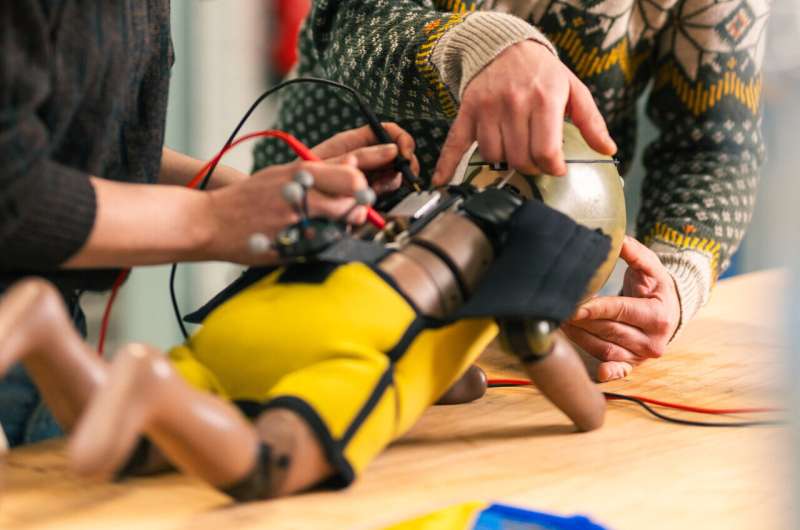This article has been reviewed according to Science X's editorial process and policies. Editors have highlighted the following attributes while ensuring the content's credibility:
fact-checked
peer-reviewed publication
trusted source
proofread
Engineers develop model to better understand injuries to babies caused by violent shaking

Shaking a baby violently can cause head and neck injuries, blindness and in some cases even death. Researchers at TU Delft, faculty of Mechanical Engineering, are using a dummy baby and computer models to map the accelerations that act on the head during shaking. They want to be able to assess the risk of injury more accurately. This could eventually lead to more clarity in legal cases on the subject.
Shaking a 1-year-old child as hard as you can. That is what the new series of experiments by researchers Arjo Loeve and Kim Hutchinson comes down to. Of course, they did not use a real child for these experiments but a dummy that is similar in size and weight to an average 1-year-old child. In recent weeks, the researchers asked 40 volunteers to shake the doll, both standing and sitting, as hard as they possibly could.
Mapping movements
"These data are extremely important," says Arjo Loeve, assistant professor in the Department of BioMechanical Engineering. Few studies worldwide have correctly measured the kinematics, or movements, during shaking. So Loeve is taking a different approach. "We use a special dummy with balls attached to the head and back. These reflect the infrared light emitted by cameras in the research room."
As a result, the researchers can precisely map the movements of the dummy's body and head during shaking. At the same time, sensors hidden inside the dummy measure the accelerations caused by the shaking. "This data, combined with the material properties of the infant's brain and neck, can then be used to estimate the likelihood of a particular scenario leading to the infant's injuries," says Ph.D. student Kim Hutchinson.
An underestimated problem
Severe head injury caused by shaking, often called shaken baby syndrome, is a form of child abuse that is difficult to diagnose. "This is partly because the symptoms caused by shaking, such as vomiting and bleeding in the brain or eyes, are consistent with other causes," says forensic radiologist Rick van Rijn of Amsterdam UMC, who was present during the study. Moreover, proving causality is a challenge. "It's very difficult to prove that these symptoms are really caused by the shaking and not by something else," adds Hutchinson.
So it is still unclear exactly how common this phenomenon is. "But it is estimated that one child per week dies as a result of violent shaking," Van Rijn says. And of the babies who survive, some suffer long-term problems such as behavioral problems and developmental setbacks. "So there is a real need for a good model and reliable data on the subject."
Revisiting the consensus
In 2023, Loeve's team published the same set of experiments using a dummy representing a 6-week-old baby. The results, published in Scientific Reports, show that their approach more realistically imitates shaking than existing methods. This has caused some commotion in the research field. "Because our research is suggesting that current risk assessments and injury thresholds, both of which are often used in court cases, should be revisited," Loeve says.
Clarity in court
Although it is often difficult to prove whether injuries were caused by shaking or something else, certain injuries or combinations of injuries set off alarm bells. "If doctors or staff at a child health care center notice these kinds of injuries, this should trigger a whole procedure. And in some cases, this will result in a lawsuit."
Soon, Loeve and Hutchinson will start a new series of experiments in which they will take the same measurements in non-violent situations. "For example, during falling and playing. This will allow us to make better comparisons between different scenarios so we can eventually determine with more certainty the cause of injuries in very young children," says Loeve.
More information: L. A. H. Schiks et al, Inflicted head-injury by shaking-trauma in infants: the importance of spatiotemporal variations of the head's rotation center, Scientific Reports (2023). DOI: 10.1038/s41598-023-42373-x


















